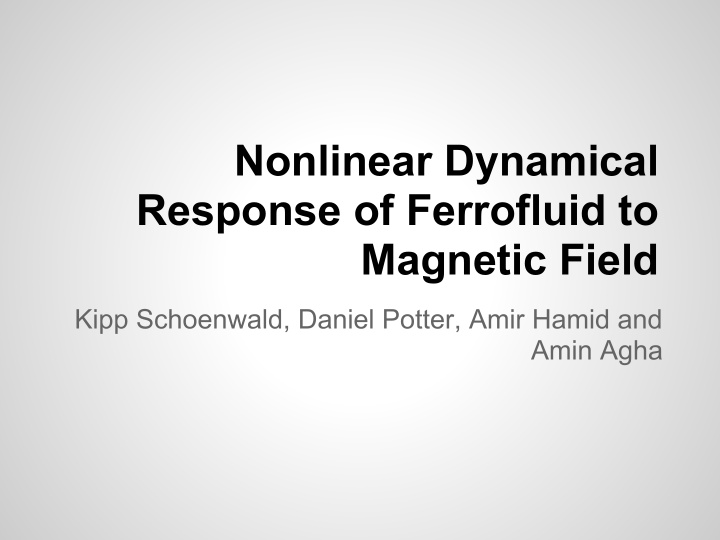



Nonlinear Dynamical Response of Ferrofluid to Magnetic Field Kipp Schoenwald, Daniel Potter, Amir Hamid and Amin Agha
Previous Work and Objective Mahr and Rehberg, "Nonlinear Dynamics of a Single Ferro-fluid Peak in an Oscillating Magnetic Field," 1998 A subcritical bifurcation is modulated via an oscillating magnetic field, in which the oscillations can be harmonic, subharmonic, or irregular depending on the frequency and amplitude of oscillation. Based on Mahr and Rehberg's work, varying the frequency and amplitude of oscillation is expected to give rise to various cyclical modes. The system is expected to exhibit period doubling.
Ferromagnetism ● The spin of the electrons are the main contribution to ferromagnetism. The dipole-dipole magnetic interaction between magnetic moments is expected to oppositely align two moments. However, this interaction is easily tampered with by thermal fluctuations. Also, at much shorter distances, the exchange interaction dominates, in which the parallel spin state (between unpaired electrons) is more stable than the antiparallel state. In this case, the spin-spin coupling between the electrons contributes significantly to the net magnetization of the material.
Ferrofluid ● Colloidal fluid mixture of oil and ferromagnetic nanoparticles (~10nm). ● The fluid becomes magnetized in the presence of a magnetic field. In deriving peaks, there are two important fluid properties: low viscosity and high magnetic permeability. Because these properties are inversely related, it is thus necessary to find a balance between the two.
Colloid behavior Why many small peaks instead of one big peak? - This is characteristic of magnetic mono-domains. Without magnetic field Magnetic field (H)
Ferrofluid in Action The fluid forms peaks that are parallel to the magnetic field lines.
Experimental Setup: 2 Iterations Coil Electromagnets: Advantage: Uniform magnetic field Disadvantage: Difficulty getting a sufficiently strong mangetic field Round Island Pole electromagnet: Advantage: Strong magnetic field (capable of 180lb pull force) Disadvantage: Nonuniform field that varies linearly with distance from magnet. Other Apparatus: Tecron 7550 Power Supply Amplifier, F.W. Bell Model 5070 Gauss/Tesla Meter, High Speed Camera: Redlake Motion Xtra HG-LE, Pipette, Ferrotec EFH-1 Ferrofluid
Experimental Setup ● Ferrofluid placed in holder (centered) under RIP magnet. ● Two Holders: 6.35 mm diameter pipette tip and 7.58 mm diameter fabricated Teflon holder ● Holder supported in sand in later trials for variable height adjustment ● White screen and light used to create contrast for motion capture of black fluid
Magnetic Field Characterization ● The magnetic field was measured as a function of the input voltage with the Tesla Meter. Spatial Field variation was measured along the vertical axis up to 13 mm below the center of the magnet. A discrepancy of 0.01T over 1.0 cm was observed.
Decay Time ● Decay time = 4.83ms
Experimental Procedure General: Vary the magnetic field and observe peak behavior using high speed camera Driving Inputs Examined ● Static DC Field ● 1 Hz Triangular wave with Amplitude 3.0-5.2 V ● 7 Hz input with varying DC offset Image Processing performed in MATLAB
Single fluid peak: dynamics
Single fluid peak: MATLAB Analysis 3.6 V triangle ramp 5.2 V triangle ramp
Analysis of Numerical Model Kipp Schoenwald
Analysis of Numerical Model Kipp Schoenwald
Analysis of Numerical Model Kipp Schoenwald
Numerical Analysis Kipp Schoenwald
Analysis of Numerical Model Kipp Schoenwald
Numerical Analysis Modified Model Though the model shows good correlation, the velocity term coefficient can not alone describe the entire fluid system. Discrepency likely lies withing fluid stiffness latency in particle alignment Kipp Schoenwald
Characterizing the fluid Fluid peak height vs magnetic field Ramp up and down, showing hysteresis Characteristic time of the fluid ~20 ms Triangle ramp, 1Hz up to 3.5V peak. Manual Triangle ramp up to 3.5V. No hysteresis.
Model: Period changes Drive function, peak height, and unimodal plot were analyzed for varying parameters. Two period Ten period
Model: Verifying period changes Period doublings show same general form. Mahr model Mahr model reiterated in Matlab
Experiment vs Theory Experimental Mahr Model T T At lower H offsets, the response periods generally agree.
Video: Odd temporal phenomena Peak height Time, s Frequency of peaks suddenly increases part way through video. Max peak height is modulated over time.
Period changes as a function of H offset, delta-H, and frequency The period fails to go chaotic even at high delta-H values!
Peak height vs H offset We didn't see the kind of bifurcation reported by Mahr, but this is partly due to differences between viscosity and magnetization of our fluid and Mahr's. What about a frequency sweep? Exploring peak height vs frequency changes was difficult, as a rise in frequency meant a decrease in peak height.
Other unexpected behavior Put this slide towards the end: 1)Sharp peak randomly appearing from fluid peak while doing slow manual ramp up. 2)Horizontal bifurcations show Lateral bifurcation how the fluid moves to the side of the well, preferring this over rising in the center of the well.
Discrepancies between experiment and theory 1. Theory relies on uniform magnetic field (Helmholtz coil). 2. Different fluid from previous work. 3. Frame rate of video capture may have been accidentally altered. Improvements: 1. Wider sweep of H offset. 2. Model to account for distance-dependence of H.
Recommend
More recommend